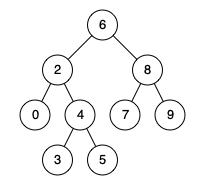Lowest Common Ancestor of a Binary Search Tree
Given a binary search tree (BST), find the lowest common ancestor (LCA) of two given nodes in the BST.
According to the definition of LCA on Wikipedia: “The lowest common ancestor is defined between two nodes p and q as the lowest node in T that has both p and q as descendants (where we allow a node to be a descendant of itself).”
Given binary search tree: root = [6,2,8,0,4,7,9,null,null,3,5]

Example 1:
Example 2:
Note:
All of the nodes' values will be unique.
p and q are different and both values will exist in the BST.
Solution & Analysis
Using attribution of a BST
Iterative
Same code as Lowest Common Ancestor of a Binary Tree
Reference
https://www.lintcode.com/problem/lowest-common-ancestor-ii/description
https://www.lintcode.com/problem/lowest-common-ancestor-iii/description
Last updated
Was this helpful?